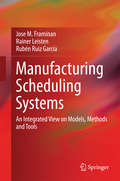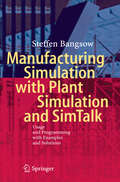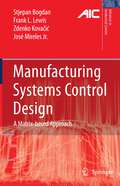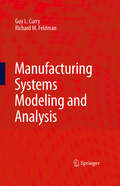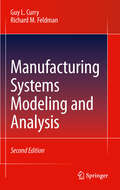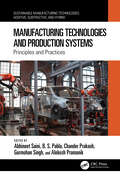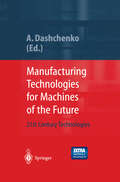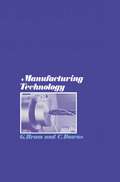- Table View
- List View
Manufacturing Parameters and Entrepreneurship: Space Consideration
by Sanjay SharmaManufacturing Parameters and Entrepreneurship provides a guide that helps business leaders understand and apply the production parameters and estimation techniques needed for commercial success. This book covers important concepts in depth, including manufacturing space, manufacturing quality, production backorders, space consideration, quality aspects, maximum inventory control, entrepreneurial application, and quality inclusion. Key features: Covers manufacturing parameters, their estimation, and effects in a single volume. Discusses conceptualization, formulation, and analysis of space consideration. Provides basic understanding and mathematical treatment of quality aspects in detail. Discusses in detail concepts such as manufacturing space, manufacturing quality, and production backorders. Covers stock out situations in detail. Manufacturing Parameters and Entrepreneurship will be an invaluable addition to the libraries of graduate students and professionals in the field of industrial engineering, production engineering, and manufacturing science and engineering.
Manufacturing Parameters and Entrepreneurship: Space Consideration
by Sanjay SharmaManufacturing Parameters and Entrepreneurship provides a guide that helps business leaders understand and apply the production parameters and estimation techniques needed for commercial success. This book covers important concepts in depth, including manufacturing space, manufacturing quality, production backorders, space consideration, quality aspects, maximum inventory control, entrepreneurial application, and quality inclusion. Key features: Covers manufacturing parameters, their estimation, and effects in a single volume. Discusses conceptualization, formulation, and analysis of space consideration. Provides basic understanding and mathematical treatment of quality aspects in detail. Discusses in detail concepts such as manufacturing space, manufacturing quality, and production backorders. Covers stock out situations in detail. Manufacturing Parameters and Entrepreneurship will be an invaluable addition to the libraries of graduate students and professionals in the field of industrial engineering, production engineering, and manufacturing science and engineering.
Manufacturing Process Design and Costing: An Integrated Approach
by Simmy GrewalThe only book to provide detailed analytical tools for manufacturing process design.No other book takes a data perspective to design, although this becoming a hot topic in research and industry.
Manufacturing Processes 1: Cutting (RWTHedition)
by Fritz KlockeThe book series on manufacturing processes for engineers is a reference work for scientific and industrial experts. This volume on Turning, Milling and Drilling starts from the basic principles of machining with geometrically defined cutting edges based on a common active principle. In addition, appropriate tool designs as well as the reasonable use of cutting material are presented. A detailed chapter about the machinability of the most important workpiece materials, such as steel and cast iron, light metal alloys and high temperature resistant materials imparts a broad knowledge of the interrelations between workpiece materials, cutting materials and process parameters.This book is in the RWTHedition Series as are the other four volumes of the reference work.
Manufacturing Processes 2: Grinding, Honing, Lapping (RWTHedition)
by Fritz KlockeThe future of manufacturing companies depends largely on their ability to adapt to swiftly changing global conditions. These are exemplified by international com- tition, rapidly growing intercommunication and the increased significance of en- ronmental issues [KLOC98a, ENGE02]. Precision machining with geometrically undefined cutting edges represents a key production engineering technology with high efficiency, security and machining quality. DIN norm 8589 subsumes within the group “machining with geometrically - defined cutting edges” the following material removal manufacturing processes: grinding, honing, lapping, free abrasive grinding and abrasive blast cutting. - chining is carried out in these production methods by means of more or less - regularly formed grains composed of hard substances brought into contact with the material. Of all methods understood as machining with geometrically undefined cutting edges, only grinding, honing and lapping can, strictly speaking, be considered p- cision machining. Free abrasive grinding and abrasive blast cutting, also treated in this book, represent a special group, as they generally cannot bring about geom- rical change in the material.
Manufacturing Processes 4: Forming (RWTHedition)
by Fritz KlockeThis book provides essential information on metal forming, utilizing a practical distinction between bulk and sheet metal forming. In the field of bulk forming, it examines processes of cold, warm and hot bulk forming, as well as rolling and a new addition, the process of thixoforming. As for the field of sheet metal working, on the one hand it deals with sheet metal forming processes (deep drawing, flange forming, stretch drawing, metal spinning and bending). In terms of special processes, the chapters on internal high-pressure forming and high rate forming have been revised and refined. On the other, the book elucidates and presents the state of the art in sheet metal separation processes (shearing and fineblanking). Furthermore, joining by forming has been added to the new edition as a new chapter describing mechanical methods for joining sheet metals.The new chapter “Basic Principles” addresses both sheet metal and bulk forming, in addition to metal physics, plastomechanics and computational basics; these points are complemented by the newly added topics of metallography and analysis, materials and processes for testing, and tribology and lubrication techniques. The chapters are supplemented by an in-depth description of modern numeric methods such as the finite element method. All chapters have been updated and revised for the new edition, and many practical examples from modern manufacturing processes have been added.
Manufacturing Productivity in China (Industrial And Systems Engineering Ser.)
by Li Zheng Simin Huang Zhihai ZhangChinese manufacturing industries continue to impact the world economy. It is important to understand what is happening in China and the uniqueness of Chinese manufacturing industries. Manufacturing Productivity in China brings together a group of authors from academia and industry to give an industrial engineering micro viewpoint instead of an econ
Manufacturing Scheduling Systems: An Integrated View on Models, Methods and Tools
by Jose M. Framinan Rainer Leisten Rubén Ruiz GarcíaThe book is devoted to the problem of manufacturing scheduling, which is the efficient allocation of jobs (orders) over machines (resources) in a manufacturing facility. It offers a comprehensive and integrated perspective on the different aspects required to design and implement systems to efficiently and effectively support manufacturing scheduling decisions. Obtaining economic and reliable schedules constitutes the core of excellence in customer service and efficiency in manufacturing operations. Therefore, scheduling forms an area of vital importance for competition in manufacturing companies. However, only a fraction of scheduling research has been translated into practice, due to several reasons. First, the inherent complexity of scheduling has led to an excessively fragmented field in which different sub problems and issues are treated in an independent manner as goals themselves, therefore lacking a unifying view of the scheduling problem. Furthermore, mathematical brilliance and elegance has sometimes taken preference over practical, general purpose, hands-on approaches when dealing with these problems. Moreover, the paucity of research on implementation issues in scheduling has restricted translation of valuable research insights into industry."Manufacturing Scheduling Systems: An Integrated View on Models, Methods and Tools" presents the different elements constituting a scheduling system, along with an analysis the manufacturing context in which the scheduling system is to be developed. Examples and case studies from real implementations of scheduling systems are presented in order to drive the presentation of the theoretical insights. The book is intended for an ample readership including industrial engineering/operations post-graduate students and researchers, business managers, and readers seeking an introduction to the field.
Manufacturing Simulation with Plant Simulation and Simtalk: Usage and Programming with Examples and Solutions
by Steffen BangsowBased on the competition of international production networks, the pressure to - crease the efficiency of production systems has increased significantly. In ad- tion, the number of technical components in many products and as a consequence also the requirements for corresponding assembly processes and logistics pr- esses increases. International logistics networks require corresponding logistics concepts. These requirements can be managed only by using appropriate Digital Factory tools in the context of a product lifecycle management environment, which allows reusing data, supports an effective cooperation between different departments, and provides up-to-date and relevant data to every user who needs it. Simulating the complete material flow including all relevant production, st- age, and transport activities is recognized as a key component of the Digital F- tory in the industry and as of today widely used and accepted. Cutting inventory and throughput time by 20–60% and enhancing the productivity of existing p- duction facilities by 15–20% can be achieved in real-life projects.
Manufacturing Strategy: The Research Agenda for the Next Decade Proceedings of the Joint industry University Conference on Manufacturing Strategy Held in Ann Arbor, Michigan on January 8–9, 1990
by John E. Ettlie Michael Burstein Avi FiegenbaumManufacturing Systems: Theory and Practice (Mechanical Engineering Series)
by George ChryssolourisOverviews manufacturing systems from the ground up, following the same concept as in the first edition. Delves into the fundamental building blocks of manufacturing systems: manufacturing processes and equipment. Discusses all topics from the viewpoint of four fundamental manufacturing attributes: cost, rate, flexibility and quality.
Manufacturing Systems and Technologies for the New Frontier: The 41st CIRP Conference on Manufacturing Systems May 26–28, 2008, Tokyo, Japan
by Mamoru Mitsuishi Kanji Ueda Fumihiko KimuraCollected here are 112 papers concerned with all manner of new directions in manufacturing systems given at the 41st CIRP Conference on Manufacturing Systems. The high-quality material presented in this volume includes reports of work from both scientific and engineering standpoints and several invited and keynote papers addressing the current cutting edge and likely future trends in manufacturing systems. The book’s subjects include: (1) new trends in manufacturing systems design: sustainable design, ubiquitous manufacturing, emergent synthesis, service engineering, value creation, cost engineering, human and social aspects of manufacturing, etc.; (2) new applications for manufacturing systems – medical, life-science, optics, NEMS, etc.; (3) intelligent use of advanced methods and new materials – new manufacturing process technologies, high-hardness materials, bio-medical materials, etc.; (4) integration and control for new machines – compound machine tools, rapid prototyping, printing process integration, etc.
Manufacturing Systems Control Design: A Matrix-based Approach (Advances in Industrial Control)
by Stjepan Bogdan Frank L. Lewis Zdenko Kovacic Jose MirelesThis book covers all the steps from identification of operations and resources to the transformation of virtual models into real-world algorithms. The matrix-based approach presented here is a solution to the real-time application of control in discrete event systems and flexible manufacturing systems (FMS), and offers a sound practical basis for the design of controllers for manufacturing systems.
Manufacturing Systems Engineering: A Unified Approach to Manufacturing Technology, Production Management and Industrial Economics
by Katsundo HitomiThis second edition of the classic textbook has been written to provide a completely up-to-date text for students of mechanical, industrial, manufacturing and production engineering, and is an indispensable reference for professional industrial engineers and managers.In his outstanding book, Professor Katsundo Hitomi integrates three key themes into the text:* manufacturing technology* production management * industrial economics Manufacturing technology is concerned with the flow of materials from the acquisition of raw materials, through conversion in the workshop to the shipping of finished goods to the customer. Production management deals with the flow of information, by which the flow of materials is managed efficiently, through planning and control techniques. Industrial economics focuses on the flow of production costs, aiming to minimise these to facilitate competitive pricing.Professor Hitomi argues that the fundamental purpose of manufacturing is to create tangible goods, and it has a tradition dating back to the prehistoric toolmakers. The fundamental importance of manufacturing is that it facilitates basic existence, it creates wealth, and it contributes to human happiness - manufacturing matters. Nowadays we regard manufacturing as operating in these other contexts, beyond the technological. It is in this unique synthesis that Professor Hitomi's study constitutes a new discipline: manufacturing systems engineering - a system that will promote manufacturing excellence.Key Features:* The classic textbook in manufacturing engineering * Fully revised edition providing a modern introduction to manufacturing technology, production managment and industrial economics* Includes review questions and problems for the student reader
Manufacturing Systems Engineering: A Unified Approach to Manufacturing Technology, Production Management and Industrial Economics
by Katsundo HitomiThis second edition of the classic textbook has been written to provide a completely up-to-date text for students of mechanical, industrial, manufacturing and production engineering, and is an indispensable reference for professional industrial engineers and managers.In his outstanding book, Professor Katsundo Hitomi integrates three key themes into the text:* manufacturing technology* production management * industrial economics Manufacturing technology is concerned with the flow of materials from the acquisition of raw materials, through conversion in the workshop to the shipping of finished goods to the customer. Production management deals with the flow of information, by which the flow of materials is managed efficiently, through planning and control techniques. Industrial economics focuses on the flow of production costs, aiming to minimise these to facilitate competitive pricing.Professor Hitomi argues that the fundamental purpose of manufacturing is to create tangible goods, and it has a tradition dating back to the prehistoric toolmakers. The fundamental importance of manufacturing is that it facilitates basic existence, it creates wealth, and it contributes to human happiness - manufacturing matters. Nowadays we regard manufacturing as operating in these other contexts, beyond the technological. It is in this unique synthesis that Professor Hitomi's study constitutes a new discipline: manufacturing systems engineering - a system that will promote manufacturing excellence.Key Features:* The classic textbook in manufacturing engineering * Fully revised edition providing a modern introduction to manufacturing technology, production managment and industrial economics* Includes review questions and problems for the student reader
Manufacturing Systems Modeling and Analysis
by Guy L. Curry Richard M. FeldmanThis textbook was developed to ?ll the need for an accessible but comprehensive presentation of the analytical approaches for modeling and analyzing models of manufacturing and production systems. It is an out growth of the efforts within the Industrial and Systems Engineering Department at Texas A&M to develop and teach an analytically based undergraduate course on probabilisticmodeling of m- ufacturingtype systems. The level of this textbook is directed at undergraduate and masters students in engineering and mathematical sciences. The only prerequisite for students using this textbook is a previous course covering calculus-based pr- abilityand statistics. The underlyingmethodology is queueing theory, and we shall develop the basic concepts in queueing theory in suf?cient detail that the reader need not have previously covered it. Queueing theory is a well-established dis- plinedatingback to theearly 1900’sworkof A. K. Erlang, a Danish mathematician, on telephone traf?c congestion. Although there are many textbooks on queueing theory, these texts are generally oriented to the methodological development of the ?eld and exact results and not to the practical application of using approximations in realistic modeling situations. The application of queueing theory to manufact- ing type systems started with the approximation based work of Ward Whitt in the 1980’s. His paper on QNA (a queueing network analyzer) in 1983 is the base from which most applied modeling efforts have evolved. There are several textbooks with titles similar to this book.
Manufacturing Systems Modeling and Analysis
by Guy L. Curry Richard M. FeldmanThis text presents the practical application of queueing theory results for the design and analysis of manufacturing and production systems. This textbook makes accessible to undergraduates and beginning graduates many of the seemingly esoteric results of queueing theory. In an effort to apply queueing theory to practical problems, there has been considerable research over the previous few decades in developing reasonable approximations of queueing results. This text takes full advantage of these results and indicates how to apply queueing approximations for the analysis of manufacturing systems. Support is provided through the web site http://msma.tamu.edu. Students will have access to the answers of odd numbered problems and instructors will be provided with a full solutions manual, Excel files when needed for homework, and computer programs using Mathematica that can be used to solve homework and develop additional problems or term projects. In this second edition a separate appendix dealing with some of the basic event-driven simulation concepts has been added.
Manufacturing Systems: Theory and Practice (Mechanical Engineering Series)
by George ChryssolourisOverviews manufacturing systems from the ground up, following the same concept as in the first edition. Delves into the fundamental building blocks of manufacturing systems: manufacturing processes and equipment. Discusses all topics from the viewpoint of four fundamental manufacturing attributes: cost, rate, flexibility and quality.
Manufacturing Techniques for Materials: Engineering and Engineered
by T. S. Srivatsan T. S. Sudarshan K. ManigandanManufacturing Techniques for Materials: Engineering and Engineered provides a cohesive and comprehensive overview of the following: (i) prevailing and emerging trends, (ii) emerging developments and related technology, and (iii) potential for the commercialization of techniques specific to manufacturing of materials. The first half of the book provides the interested reader with detailed chapters specific to the manufacturing of emerging materials, such as additive manufacturing, with a valued emphasis on the science, technology, and potentially viable practices specific to the manufacturing technique used. This section also attempts to discuss in a lucid and easily understandable manner the specific advantages and limitations of each technique and goes on to highlight all of the potentially viable and emerging technological applications. The second half of this archival volume focuses on a wide spectrum of conventional techniques currently available and being used in the manufacturing of both materials and resultant products. Manufacturing Techniques for Materials is an invaluable tool for a cross-section of readers including engineers, researchers, technologists, students at both the graduate level and undergraduate level, and even entrepreneurs.
Manufacturing Techniques for Materials: Engineering and Engineered
by T. S. Srivatsan T. S. Sudarshan K. ManigandanManufacturing Techniques for Materials: Engineering and Engineered provides a cohesive and comprehensive overview of the following: (i) prevailing and emerging trends, (ii) emerging developments and related technology, and (iii) potential for the commercialization of techniques specific to manufacturing of materials. The first half of the book provides the interested reader with detailed chapters specific to the manufacturing of emerging materials, such as additive manufacturing, with a valued emphasis on the science, technology, and potentially viable practices specific to the manufacturing technique used. This section also attempts to discuss in a lucid and easily understandable manner the specific advantages and limitations of each technique and goes on to highlight all of the potentially viable and emerging technological applications. The second half of this archival volume focuses on a wide spectrum of conventional techniques currently available and being used in the manufacturing of both materials and resultant products. Manufacturing Techniques for Materials is an invaluable tool for a cross-section of readers including engineers, researchers, technologists, students at both the graduate level and undergraduate level, and even entrepreneurs.
Manufacturing Techniques for Microfabrication and Nanotechnology
by Marc J. MadouDesigned for science and engineering students, this text focuses on emerging trends in processes for fabricating MEMS and NEMS devices. The book reviews different forms of lithography, subtractive material removal processes, and additive technologies. Both top-down and bottom-up fabrication processes are exhaustively covered and the merits of the d
Manufacturing Technologies and Production Systems: Principles and Practices (Sustainable Manufacturing Technologies)
by Abhineet Saini B. S. Pabla Chander Prakash Gurmohan Singh Alokesh PramanikThe book, which is part of a two-volume handbook set, presents a collection of recent advances in the field of industrial engineering, design, and related technologies. It includes state-of-the-art research conducted in the fields of Industry 4.0/5.0, smart systems/industries, robotics and automation, automobile engineering, thermal and fluid engineering, and its implementation.Manufacturing Technologies and Production Systems: Principles and Practices offers a comprehensive description of the developments in industrial engineering primarily focusing on industrial design, automotive engineering, construction and structural engineering, thermo-fluid mechanics, and interdisciplinary domains.The book captures emerging areas of materials science and advanced manufacturing engineering and presents the most recent trends in research for emerging researchers, field engineers, and academic professionals.
Manufacturing Technologies and Production Systems: Principles and Practices (Sustainable Manufacturing Technologies)
The book, which is part of a two-volume handbook set, presents a collection of recent advances in the field of industrial engineering, design, and related technologies. It includes state-of-the-art research conducted in the fields of Industry 4.0/5.0, smart systems/industries, robotics and automation, automobile engineering, thermal and fluid engineering, and its implementation.Manufacturing Technologies and Production Systems: Principles and Practices offers a comprehensive description of the developments in industrial engineering primarily focusing on industrial design, automotive engineering, construction and structural engineering, thermo-fluid mechanics, and interdisciplinary domains.The book captures emerging areas of materials science and advanced manufacturing engineering and presents the most recent trends in research for emerging researchers, field engineers, and academic professionals.
Manufacturing Technologies for Machines of the Future: 21st Century Technologies
by Anatoli I. DashchenkoThe most up-to-date view of manufacturing technologies. Written by leading experts from the USA, Europe, and Asia, both handbook and CD-ROM cover a wide range of topics ranging from industrial management and organization to automation and control, from mechanical to electronical technology, and from machine tools to the consumer goods industry. It gives a unique interdisciplinary and global presentation of material and combines, for the first time, theoretical and significant practical results from the last decades of the most important branches of machine building. Its broad coverage appeals to the highly skilled scientific expert as well as the experienced design engineer, and to undergraduate and advanced students.






